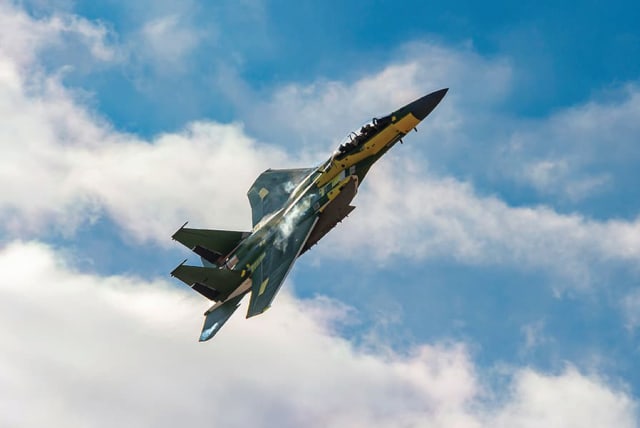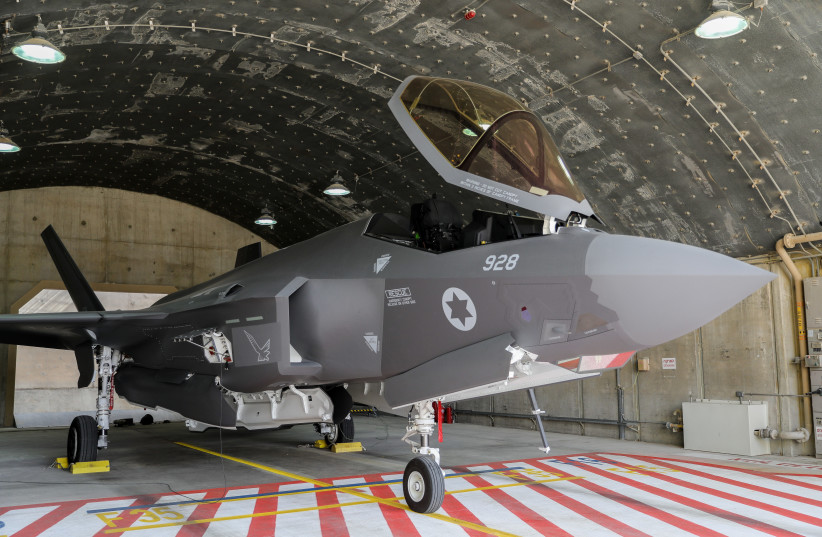Israel needs mix of F-35, F-15 fighter jets for air superiority - opinion

IAF head Maj.-Gen. Tomer Bar will need to fight for a plan that will ensure Israel’s qualitative edge and aerial superiority for decades to come.
Fifty years ago Wednesday, the United States made history. A plane with a long nose, two engines and orange-painted wings took off from Edwards Air Force base in California for its maiden flight.
It was a resounding success. Made by McDonnell Douglass, the F-15 Eagle, as the plane would be called, would go on to change the face of aerial combat. Designed as a dedicated air superiority fighter plane, it has become one of the most successful combat aircraft in the world.
The majority of its kills were honed by the Israeli Air Force, which received the planes four years later and has used it ever since in combat missions across the entire Middle East.
It was the first time that a fourth-generation aircraft had arrived in the Middle East, and before even using it, pilots felt that Israel had created a new level of deterrence. Syria and Egypt now understood, just three years after the Yom Kippur War, that the next war would not look the same.
Is the IAF slipping?
Israel still maintains aerial superiority, but over the last year, the IAF looks like it’s slipping. Not a slip yet felt in the region, but if decisions are not made soon, the famous qualitative edge that Israel has hailed as necessary for its continued existence will suffer a devastating blow.

While Israel does not reveal the size of its fleet, the IAF is reported to have around 600 aircraft. This includes fighter jets, transport aircraft and helicopters. But because of budget cuts and the need to retire old planes that can no longer fly, the military has been downsizing over recent years.
For example, the IAF has retired a number of older-model F-16s. Some of them were replaced by the F-35 Joint Strike Fighter, of which Israel now has three squadrons. The problem is that more planes are in line to be retired in the very near future, and if new planes are not ordered, the Air Force could find itself with a fleet made up solely of F-35s, F-16s (of which it purchased 102 in the mid-2000s) as well as one squadron of F-15Is, known as the Ra’am, which has already been flying for 25 years.
Considering the threats Israel faces in the Middle East – from Hamas in Gaza to Hezbollah in Lebanon, and Iran’s nuclear program – there is no question that the IDF needs to continue to retain aerial superiority, which is ensured by having the largest, strongest and most advanced air force in the Middle East.
While the F-35 is considered one of the world’s most advanced fighter jets, it is limited in the weapons it can carry since they have to be stored in internal munition compartments in order to retain a low radar stealth-like signature.
An F-15I, on the other hand, can carry over 10 tons of different bombs that hang from its fuselage and wings. That amount of firepower gives one jet the ability to engage multiple targets on one single sortie.
And while everyone within the IDF and the Air Force recognize that this is important, IDF Chief of Staff Lt.-Gen. Aviv Kohavi and new IAF commander Maj.-Gen. Tomer Bar have been dragging their feet. Partly it’s the fear of having to make a decision that will lock up budgets for the next decade, and also the failure to find the necessary money for procurement.
The money is hard to find because Israel typically pays for its aircraft with the annual foreign military aid that it receives from the US. Under the current Foreign Military Financing (FMF) program, set to expire in 2027, Israel receives $3.8 billion, most of which is already locked in and earmarked for existing projects like missile defense and other aircraft sales that have been approved.
Could Israel potentially set aside $1 billion a year for the next few years to pay for the new planes? Of course.
Buying planes and US money
Now, try raising that possibility – of using money that is not FMF – and defense officials will look at you like a heretic. It is sacrilegious to call for Israel to pay for planes with money that does not come from the Americans – if such a thing were to happen, it would undermine the FMF program. If Israel can pay for planes on its own, people would argue, then why does it need American assistance to begin with?
If non-FMF money is not an option, there is an idea that has been presented to Defense Minister Benny Gantz for how to open up some of the American money for more plane deals. One would be to stop using $500 million out of the annual $3.8 billion to buy jet fuel and aviation petroleum. Fuel is not weapons and can be bought with non-FMF money. Doing so would cause a shake-up in the IDF, but it would also open up American funds for the planes that Israel needs.
This is not the first time that feet dragging has held up desperately needed military platforms. Last July, the State Department approved the sale of 18 Sikorsky CH-53K King Stallion heavy-lift helicopters to replace the IAF’s aging fleet of CH-53 Yasurs.
The Yasurs, which first entered service in 1969, has for 53 years been the air force backbone as the primary helicopter to transport soldiers and equipment. But they are old and falling apart. Some pilots speak of real danger when they are airborne.
Like anything in the IDF, there are priorities, and transport helicopters have never been at the top. Every year the decision was either delayed or got stuck. There were budget fights, four elections, and personnel changes in the Defense Ministry.
The deal was finally approved last summer. That is good, right? Somewhat. The first helicopters are not scheduled to begin arriving until 2026, and the IAF has no idea how the existing choppers will fly until then.
And then there are the refueling tankers, which the IAF desperately needs. The IAF uses a fleet of 707 commercial aircraft that were converted into refueling tankers, but there too, some of those planes have been flying for nearly 60 years. That is too long.
In 2020, the State Department approved the sale of up to eight KC-46 tanker aircraft and related equipment for an estimated cost of $2.4 billion. Are the planes coming soon? Not really. The deal has not been finalized and is still being negotiated. But if the IAF wants to consider flying to Iran to carry out a bombing raid or somewhere else not within Israel’s existing combat radius, it will need refueling tankers. This is crucial.
I can imagine what you might be thinking: this can’t be right. There is no way that the IAF and the Defense Ministry have allowed this situation to deteriorate to such an extent.
A deteriorating situation
Unfortunately, they have, and time is not on Israel’s side. The challenges are growing – just listen to Hezbollah leader Sheikh Hassan Nasrallah’s speech this week. But planes take years to build, and more years until they arrive and become operational. There is no such thing as ordering a plane today and getting it next week or even next year.
Assembly lines – like the one for the F-15EX – are currently in the middle of building planes for the US Air Force and other customers. Israel can’t just skip the line.
The IAF needs to be thinking five and 10 years ahead all the time. Generals like Bar can’t just be thinking about the challenges he will face tomorrow or even next year, but rather about the enemies and the types of threats his pilots will need to fly against in 2030 and beyond.
Decisions made today will impact the way the State of Israel will be able to defend itself for the next 50 years. Literally.
Something happened in the IDF over the last few years that prevented these decisions from being made. Poor planning, ego battles, and of course the non-stop elections all led to a paralysis that took hold not only over Israel’s government system, but also what was supposed to be the “Holy of Holies” of the military: the vaunted IAF.
There is little doubt among the IAF top brass that there needs to be a mix of F-35s and F-15s. The F-35s, with their low radar signature and stealth-like capability, can open the skies by infiltrating an enemy country and taking out their radar and surface-to-air missile systems. Next comes a wave of F-15s, which can fly farther than the F-35 without refueling and carry far more munitions.
The other advantage of the F-15 over the F-35 is that Israel will be able to install its own indigenous systems on the planes, something that it had to fight for every step of the way during the configuration of the Adir, the Israeli version of the F-35.
Bar, the IAF’s new commander, is the man who will need to finalize Israeli preparations for a possible strike against Iran’s nuclear facilities. But first, he will need to fight for something else that could just as easily determine his legacy: a properly organized procurement plan that will ensure Israel’s qualitative edge and aerial superiority for decades to come.
Let’s hope he succeeds.
Jerusalem Post Store
`; document.getElementById("linkPremium").innerHTML = cont; var divWithLink = document.getElementById("premium-link"); if (divWithLink !== null && divWithLink !== 'undefined') { divWithLink.style.border = "solid 1px #cb0f3e"; divWithLink.style.textAlign = "center"; divWithLink.style.marginBottom = "15px"; divWithLink.style.marginTop = "15px"; divWithLink.style.width = "100%"; divWithLink.style.backgroundColor = "#122952"; divWithLink.style.color = "#ffffff"; divWithLink.style.lineHeight = "1.5"; } } (function (v, i) { });
